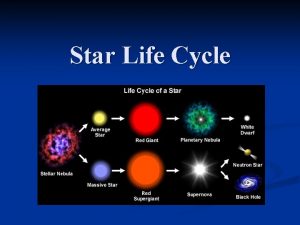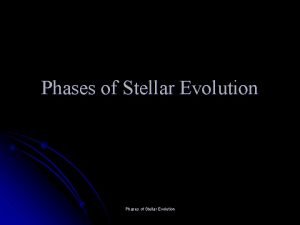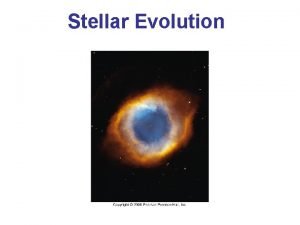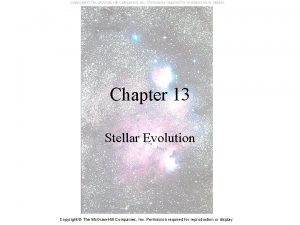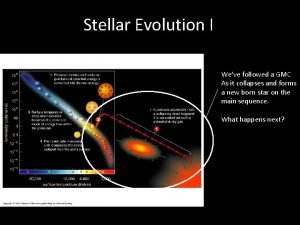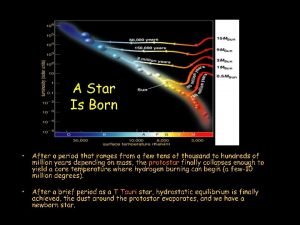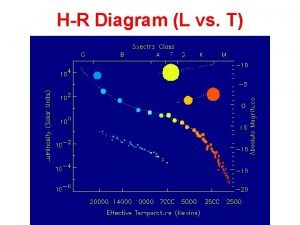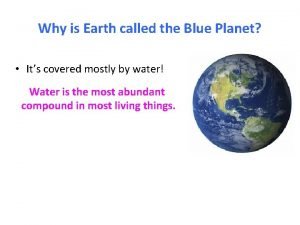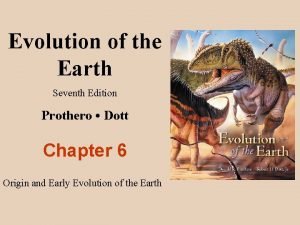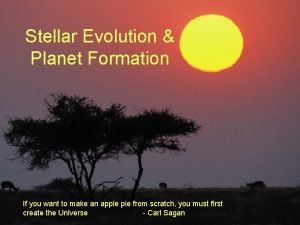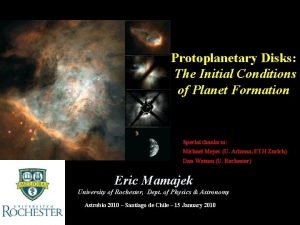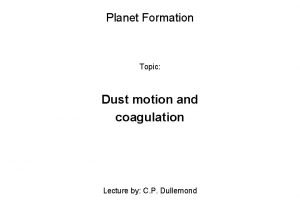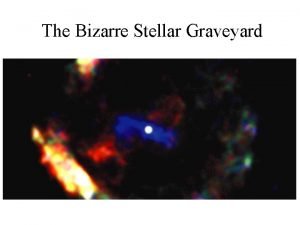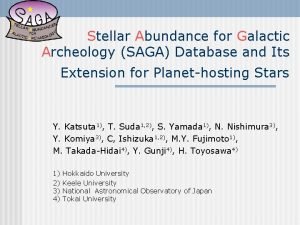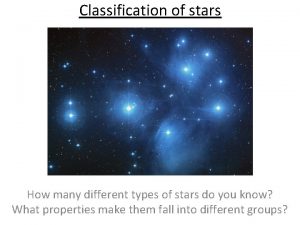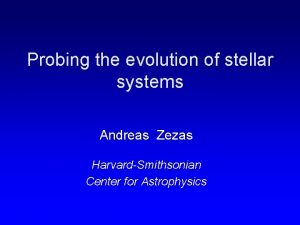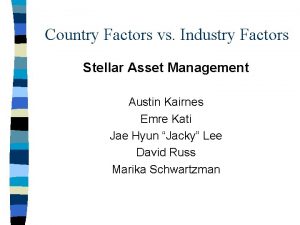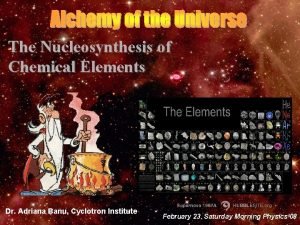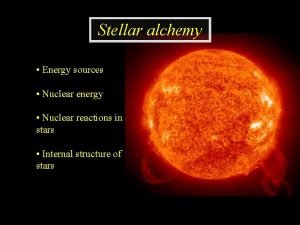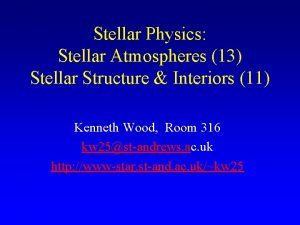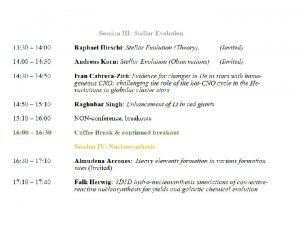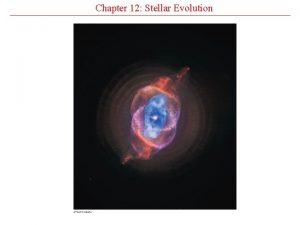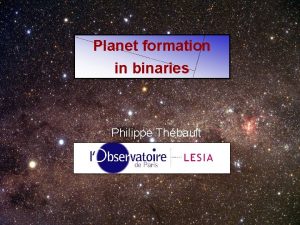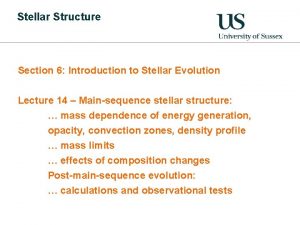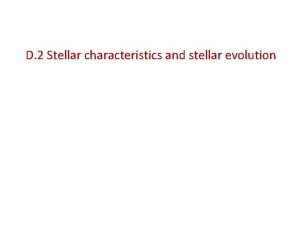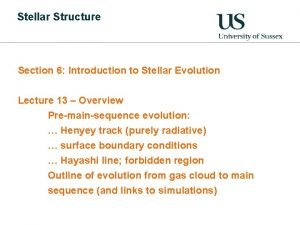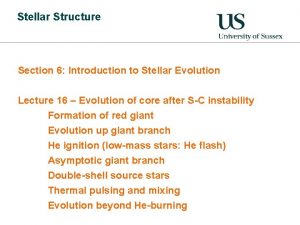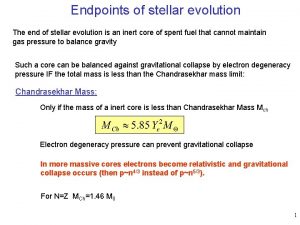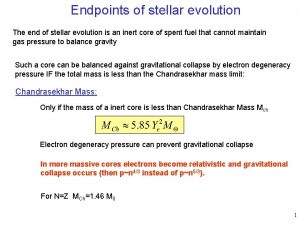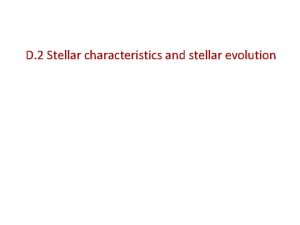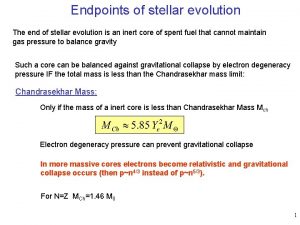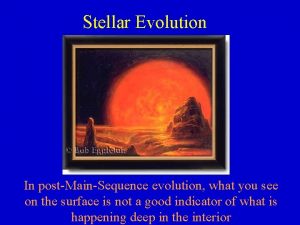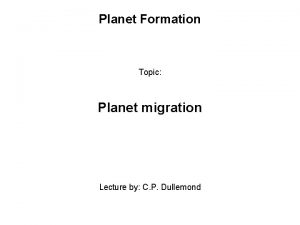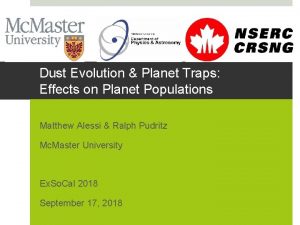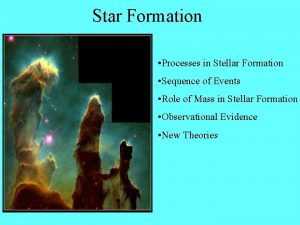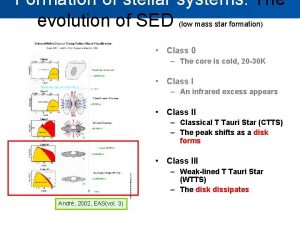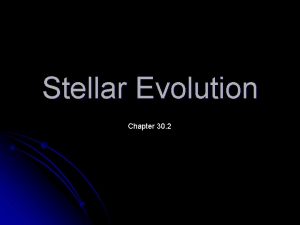Stellar Evolution Planet Formation If you want to







































- Slides: 39

Stellar Evolution & Planet Formation If you want to make an apple pie from scratch, you must first create the Universe - Carl Sagan

Review of Planetary Formation

Summary of Planetary Characteristics • Planets orbit in nearly the same plane (the ecliptic plane), inclinations are small. • Planets orbit in the same direction with small eccentricities. The direction is that which the sun rotates. • Most of the planets spin in the same direction that they orbit. Venus, Uranus and Pluto are exceptions. • Disk of planets, rotating in same direction • Rocky planets near Sun, icy planetary cores and moons further out • Little planets near Sun, big guys further out. • Big planets have big hydrogen atmospheres The clues towards understanding planetary formation

The Nebula Hypothesis The solar system (planets, satellites, asteroids, comets, etc. ) formed along with the Sun 4. 5 Byr ago from the gravitational collapse of an interstellar cloud of gas and dust. The planets and Sun formed from the same reservoir of interstellar matter and are therefore composed of primarily the same elements. As the cloud collapsed under the force of gravity it began to spin rapidly and then flattened into a plane. This explains why the solar system is a relatively flat plane and why the planets orbit in the same direction and tend to rotate in the direction that they orbit. The collapsing cloud of gas and dust was hottest near the Sun and coolest far from the Sun. The local temperature determined which compounds solidified from the gas phase as a function of distance from the Sun. This explains why the inner planets are composed mostly of rock and the outer planets have large complements of ice. Ice forming elements are more abundant than rock forming elements so planets in the outer solar system are larger. In fact they are so large that their gravitational fields were able to capture the H and He in the cloud. The gravity of the inner planets is too weak to hold on H and He. This explains why the outer planets are gaseous and the inner planets are rocky.

Accretion of the Planets

Condensation in the Solar Nebula High Density Low Density

Characteristics of the Sun SUN Radius 696, 000 km (109 RE) Mass 2 x 1030 kg (3 x 105 ME) Composition H 2, He, other Temperature 5800 K (surface) 1. 55 x 107 K (center) Distance (Galactic Center) 26, 000 lyr Distance from Earth 8. 32 lmin Orbital period 220 million years Luminosity 4 x 1026 W The Sun’s luminosity corresponds to the burning of 1500 lb of coal every hour on every square foot of the Sun’s surface - Hermann von Helmholtz, 1871

What keeps the Sun from collapsing

Answer: Energy generated from nuclear reactions at the Sun’s Center. Notice the neutrino.

Neutrino Experiment Neutrinos act only very weakly with matter, even the vast bulk of the Sun offers little impediment. The detector consists of 100, 000 gallons of cleaning fluid (C 2 Cl 4). The neutrino occasionally strikes a neutron of Cl, converts it to radioactive Ar (by converting a proton into a neutron). The amount of Ar is flushed out of the system and then measured. Davis Solar Neutrino Experiment (Gold Mind SD)

Sun Spots Sun spots are low temperature regions of the photosphere.

The Solar Cycle The number of Sun spots varies with a period of about 11 years. The most recent sunspot maximum occurred in 2000. Just after sunspot minimums the sunspots appear poleward of 30 latitude. As the cycle progresses the spot production migrates towards the equator.

Sunspots are produced by the 22 cycle of the magnetic field

Stars dim with the square of their distance away from us. If we know the distance from the star, e. g. from parallax, we then know the luminosity (the power that they radiate). Many stars are quite a bit larger than the Sun.

There exist stars of a range of sizes. What establishes a star’s size is its mass and age.

When the Sun finishes burning H in its core, it will collapse, until the core heats up enough to fuse He. Helium then fuses to carbon in the core. A shell surrounding the core heats up enough to fuse H into He. Once He is used up, the core collapses again. Yet, for small stars, like the Sun, temperatures never reach the 600 million K needed to burn C. What stops the collapse? Electrons, which by Fermi’s law never occupy the same place. The Sun will shrink to the size of Earth. The electrons will exert a pressure that sustains the white dwarf against further collapse.

Stars more massive than the Sun achieve higher temperatures in their cores, and are capable of fusing higher elements as a result.

As the core collapses, the outer part of the star cools. This increases the opacity of the star’s atmosphere, thereby hindering the escape of energy. The star thus expands until it can radiate the power that it makes. The now puffedup star is called a supergiant. The Sun, at this stage, will be 70 times its present radius and will engulf Mercury.

We come from the stars Heavy elements are ultimately made from H through several processes: Helium Capture: C (3 He), O (4 He), Ne (5 He), Mg (6 He), Si (7 He). Photodisintegration ( rays break nuclei) + He capture: S, Ar, Ca, Fe Slow neutron capture, s-process: copper, silver, lead, & gold Rapid neutron capture, r-process: (in super nova) and forms elements > bismuth 209 Note: Fe has the highest binding energy. Energy is needed to fuse Fe into higher elements. This, we will see, has dire consequences for the lives of stars.

The abundances of elements are determined by their binding energies, their tendencies to decay, break apart, and capture nucleons. These processes depend on the temperature & pressure of the elements and their internal nuclear structure.

Summary • Most elements are synthesized in the interior of Stars. • The heaviest, and least abundant, elements are synthesized in supernova. • Our Sun is presently burning H in its core. In 4. 5 billion years it will use up the H in the core and collapse. When temperatures are hot enough it will burn carbon. When the carbon is exhausted it will collapse again. Electrons will terminate the collapse, once the Sun reaches Earth size. The Sun will become a white dwarf. • More massive stars are able to achieve temperatures hot enough to synthesize heavier elements. • The Sun’s magnetic field reverses every 11 years, producing a periodicity to the sun spots and solar activity.

The Death of Stars The Bigger They are the Harder They Fall

The Fate of Our Sun • Our Sun is large enough to burn hydrogen into helium and helium into carbon, but the nuclear reactions will go no further. • All its fuel will be spent in about 5 byr. It will spend some time as a red giant, but eventually end as a white dwarf. • It is remarkable and important (for us) that the Sun is relatively stable with constant output for most of its 11 Byr life.

Electron Degeneracy, Planetary Nebulae, and White Dwarfs Once the fuel runs out, solar mass stars collapse violently, expelling the outer layers of gas and creating a planetary nebulae, shown to the right (Planetary nebulae have nothing to do with planets). Further collapse is prevented not by the temperature of the star, but by the pressure caused by electrons. According to the Pauli exclusion principle, it is impossible for 2 electrons to occupy the same state; thus, there is a limit to how tightly electrons can be packed. Electrons packed this tightly are called degenerate. The electrons in white dwarf stars are degenerate. White Dwarf Planetary Nebula In white dwarf stars there is a balance between gravity and electron pressure. No nuclear reactions are occurring and white dwarfs cool very slowly over time.

The White Dwarf Sirius B • Temperature = 24, 790 K = 4. 29 Solar • Radius = 5838 km = 0. 0084 Solar = 1. 15 Earth • Mass = 2. 06 1030 kg = 1. 034 Solar • Density = 2. 5 103 g/cc = 2000 Solar • Luminosity =. 0025 Solar 1 teaspoon of Sirius B weighs 5 tons In the constellation of Orion’s dog

Supernova and Neutron Stars • A different fate awaits stars with masses greater than ~8 Solar Masses. • If the force of gravity is strong enough, electrons and protons combine, creating neutrons e + p n + neutrino • Quickly, all the electrons and protons in a star are converted to neutrons. Enormous amounts of energy are released in a supernova explosion. • The stellar remnant left behind is composed completely of neutrons, i. e. a neutron star.

Supernova 1987 A Supernova have been important historically. Tycho and Kepler both observed supernova. The only supernova in modern time, visible to the naked eye, was detected on Feb. 23, 1987 and is known as SN 1987 A. A tremendous amount of energy is released in a supernova. SN 1987 A emitted more than 100 billion times as much visible light as the Sun for over one month! Temperatures as high as 2 1011 K were reached. Sanduleak Images of the star Sanduleak before and after it went supernova. Something to think about: Sanduleak is 169, 000 lightyears from Earth. This means that SN 1987 A actually occurred in 167, 000 BC.

Neutrinos from Supernova • Neutrinos are emitted when electrons and protons combine to form neutrons. • Most of the energy of a supernova is carried off by neutrinos, for SN 1987 A this was 1046 Watts. • Roughly 1013 neutrinos from this supernova passed through your body on Feb 24, 1987. • Neutrinos interact so weakly with matter that only about one dozen neutrinos were measured at the world’s largest neutrino detectors. Davis Solar Neutrino Experiment (Gold Mind SD)

Supernova Remnants The image to the right shows the remnant of SN 1987 A several years after the explosion. The two bright stars are far from SN 1987 A and have no relation to it, they just happen to be in the field of view. The bright ring is hot gas and dust expelled in the explosion and now expanding into space. The two larger, fainter rings were unexpected and remain a mystery. We believe that an as yet undetected neutron star lies at the center of the expanding ring.

Neutron Stars • Collapse of massive stars stops when the gravitational force is balanced by the pressure of neutrons. • Neutrons, like electrons, obey the Pauli exclusion principle. • Neutron stars are essential a massive nucleus. A typical Neutron star is as 1. 5 x as massive as the Sun, but has a diameter of ~10 km. The density of a neutron star is 1014 g/cc; one teaspoon weighs one billion tons. Gravity on the surface of a neutron star is 30, 000 times stronger than on the surface of the Earth.

The Crab Nebula and Pulsars In 1054, Chinese astronomers recorded a supernova in the region now known as the crab nebula. ”In the 1 st year of the period Chih -ho, the 5 th moon, the day chich'ou, a guest star appeared. . . After more than a year it gradually became invisible. . . " More than 900 years later, a pulsar was detected at the center of the nebula. Pulsars are objects that emit radiation at radio wavelengths with a very regular frequency, as shown to the left.

Pulsars are thought to be Rotating Neutron Stars As a star collapses in a supernova its magnetic field is preserved, but intensified as it is squeezed into a smaller object. Similarly the neutron star will rotate, as did the original star, but much faster (think about a twirling ice skater). Charged particles trapped by the magnetic field will radiate energy at radio wavelengths, but most of this radiation comes out along the poles of the pulsar. The radio emissions are like a searchlight and we only detect them when the searchlight passes over the Earth. There must be many more pulsars than we observe, since most of the radio beacons will miss the Earth. Pulsar rotation periods can be as small as a fraction of a second. Pulsars have been detected in xrays as well as radio wavelengths.

What happens when the mass of the collapsing star is great enough to overwhelm the neutron degeneracy pressure? X-ray image of Cygnus X-1 from NASA’s Marshall Flight Center.

Escape Velocity Let’s re-think Newton’s experiment. If you launch something from Earth with a high enough velocity, it goes into orbit. If the velocity is increased further it can escape. The escape velocity depends of the mass and radius of Earth.


Schwartzchild Radius What if vesc = c (300, 000 km/s) ? This happens at a distance from mass M: R = 2 GM/c 2, known as the Schwartzschild radius. Both matter and light within this distance to a black hole (inside the Schwartzschild radius) can not escape.

Black Holes in Binary Systems The most straightforward way to search for a black hole is to Kepler’s third law. The best place to apply this technique is an x-ray binary. In these systems one of the stars is seen in visible light and the other is a copious source of x-rays. The x-rays show the position of the (possible) black hole. How do x-rays escape from a black hole? They don’t. The x-rays are emitted by matter from the visible star that falls into the black hole accelerating to velocities near the speed of light as it falls. If we can determine the orbital period of the binary system, we can then use Kepler’s 3 rd law to calculate the mass. If the mass of the unseen companion is large, this and the presence of x-rays suggest that it is a black hole. Currently, the best candidate is Cygnus X-1.

Super Massive Black Holes An x-ray image of the center of the Milky Way The center of our galaxy is also a copious source of x-rays and appears to be extremely massive. Stars in the Milky Way orbit around an unseen central object. Analysis of the orbital velocities of the stars about the center of the galaxy (using Kepler’s 3 rd law) imply a mass of 2. 6 106 solar masses inside a volume 0. 03 light years in diameter. It is impossible to pack stars together that tightly – they would collide, destroying each other very quickly. It is likely that the object at the center of our galaxy is a super massive black hole. The same is believed to be true of many other galaxies.

Summary • Stars die by expelling catastrophically the outer layers. The inner layers contract to a very dense amber. • Massive stars (8 x Ms) explode into supernova, while solar-type stars explode as less energetic planetary nebula. • The remnant of the Sun will be a white dwarf, supported by electron degeneracy. • The remnant of a massive star is a neutron star, supported by neutron degeneracy. • A stellar core more than 3 Ms has enough gravity to overwhelm the neutron degeneracy pressure. No known force can support gravity and collapse continues. The result: a black hole. • The Schwarzschild radius is the distance from a black hole where even light can not escape.
 Stellar evolution diagram
Stellar evolution diagram Stellar evolution diagram
Stellar evolution diagram Life cycle of a star poster
Life cycle of a star poster Stellar evolution
Stellar evolution Stellar evolution
Stellar evolution Stellar evolution
Stellar evolution Hr diagram
Hr diagram Stellar formation
Stellar formation Why is the earth called the blue planet
Why is the earth called the blue planet Planet formation
Planet formation Planet formation
Planet formation Planet formation
Planet formation Planet formation
Planet formation Spoken word poetry allows you to be anyone you want to be
Spoken word poetry allows you to be anyone you want to be Formation initiale vs formation continue
Formation initiale vs formation continue Stellar heaven
Stellar heaven Astronomy
Astronomy Stellar motion matlab
Stellar motion matlab Virgo stellar stream
Virgo stellar stream Masses in the stellar graveyard
Masses in the stellar graveyard Stellar hosting iptv
Stellar hosting iptv Stellar assessment
Stellar assessment Stellar saga
Stellar saga What is stellar parallax?
What is stellar parallax? Stellar
Stellar Stellar asset management
Stellar asset management Adriana banu
Adriana banu Stellar wifi
Stellar wifi Stellar alchemy
Stellar alchemy For you and planet blue
For you and planet blue Indirect speech
Indirect speech Lirik lagu more more more we praise you
Lirik lagu more more more we praise you More more more i want more more more more we praise you
More more more i want more more more more we praise you Why do you want to work for us
Why do you want to work for us Unit 5 grammar future time
Unit 5 grammar future time Go con ing
Go con ing So you want to be a social worker
So you want to be a social worker Favorite motto
Favorite motto Propaganda strategy
Propaganda strategy Motivated last thing you want do
Motivated last thing you want do
